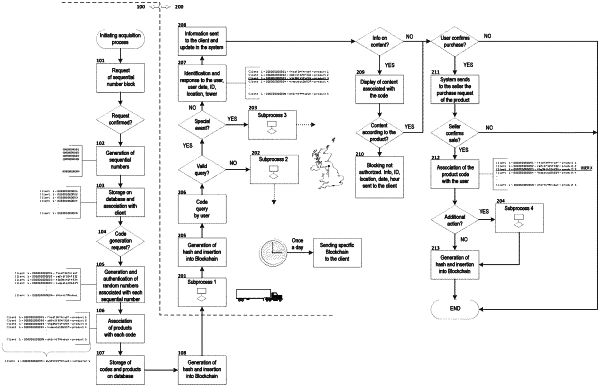| CPC G06Q 30/0635 (2013.01) [G06Q 30/0639 (2013.01); G06Q 2220/00 (2013.01)] | 21 Claims |

|
1. A method for tracking products comprising:
generating, by a system server, a plurality of generated numbers comprising a sequentially generated first part and a randomly generated second part, and generating a plurality of codes based on the plurality of generated numbers;
associating, by a client, at least one code of the plurality of codes with at least one product of a plurality of products;
storing, by the system server, the associated at least one code with the at least one product in a database;
periodically generating a hash of transactions made in the database, and inserting the generated hash into a blockchain associated with the client;
sending, by a sender and to a recipient, the at least one product associated with the at least one code;
checking, by the system server, for a loss or theft of the at least one product sent by the sender to the recipient;
in the absence of any loss or theft, and after receiving the at least one product by the recipient, checking, by the recipient, a validity of the at least one code of the at least one product by means of a validation equipment;
performing a first alarm action for the client when the code is invalid, or updating, by the system server, the current geolocation data of the at least one product in the database when the code is valid;
checking, by a user, the validity of the at least one code of the at least one product by means of the validation equipment;
performing a second alarm action for the client and for the user when the at least one code is invalid, or checking, by the system server, if an additional alarm has occurred when the at least one code is valid;
performing, by the system server, the additional alarm in the event the additional alarm has occurred, or sending, by the validation equipment, identification data of the user, a date, a time and the current geolocation data of the at least one product to the system server, and sending, by the system server, product identification data and, if available, product content data, to the user, in the absence of the additional alarm;
sending at least one product enquiry information to the client and updating the identification data of the user, the date, the time and geolocation of the at least one product in the database;
confirming, by the user to the system server, that a purchase of the at least one product associated with the at least one code is validated;
sending, by the system server to a seller, information that a purchase requisition for the at least one product has been requested, and generating a “pending purchase” status associated with the at least one product in the database;
when the purchase of the at least one product by the seller is confirmed, associating, by the system server, the at least one code with the user, and changing the status to “blocked” in the database;
when the status has been changed to “blocked” in the database, checking, by the system server, if there is an additional action; and
performing, by the client, the additional action,
wherein the step of performing the second alarm action for the client comprises:
checking, by the system server, the validity of a client's own code for the at least one product;
notifying, by the system server, to inform the user and the client of a possible fraud when the client's own code for the at least one product is valid, and sending, by the system server to the client, the current geolocation data for the at least one product;
notifying, by the system server, the user of a possible fraud, when the client's own code for the at least one product is invalid;
requesting, by the system server to the user, that the user identify the at least one product, in response to the determination that the client's own code for the at least one product is invalid,
providing the client the current geolocation data of the at least one product, in response to the determination that the client's own code for the at least one product is invalid when the at least one product is identified by the system server,
sending data requested from the user to identify the at least one product from the system server to the client when the user uploads the data requested from the user to identify the at least one product for the at least one product, in response to the determination that the client's own code for the at least one product is invalid.
|